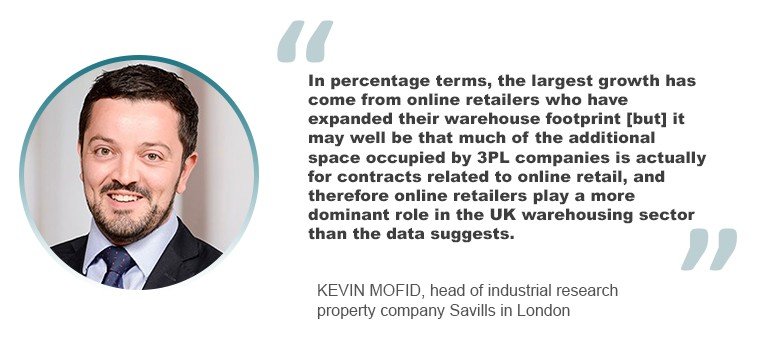Changes in the United Kingdom’s warehousing sector look set to support the booming e-commerce trade, with those in Asia also unlikely to suffer significant problems as e-commerce keeps growing at a blistering pace.
Not only are UK warehouses growing in number, size and height but Asia’s are keeping pace, too.
A recent report from property firm Savills showed in the six years since 2015, Britain’s total amount of warehouse stock increased by 32%, much of it the result of the e-commerce bonanza, to 566 million square feet (sq ft), a rise of 138 million sq ft.
“In percentage terms, the largest growth has come from online retailers who have expanded their warehouse footprint from 8 million sq ft to 60 million sq ft, a rise of 614%,” Kevin Mofid, head of industrial research at Savills in London told Asia Cargo News.
Significant though this is, it important not to lose sight of the broader picture, where 3PL companies such as Wincanton, Eddie Stobart and DHL are actually the occupier grouping with the largest footprint, accounting for 106.5 million sq ft – some of which supports e-commerce, noted Mofid.
“It may well be that much of the additional space occupied by 3PL companies is actually for contracts related to online retail, and therefore online retailers play a more dominant role in the UK warehousing sector than the data suggests,” said Mofid.
The growing needs of e-commerce are not the only development the Savills report noted.
There has been a trend of warehouses getting larger and taller to accommodate more inventory. Eave height of warehouses has, on average, increased from 11 metres to 14 metres since 2015. Skyscraper-warehouses are unlikely, though, Mofid said.
“There will be a natural ceiling as to how large warehouses get before they become (too) inefficient to operate,” he said.
Bigger warehouses are also emerging. Savills maintains a database of all new warehouse requirements in the market; over the past 18 months, a third of those have been for units over 500,000 sq ft, meaning that in the medium term, the average-sized warehouse in the UK will be larger.
No-one ACN contacted believed a warehouse crunch was inevitable, especially locally.
“At this moment in time there is plenty of available capacity in Asia. However, should there be a material increase in demand for warehouse space this will potentially affect the entire industry. We are also constructing new facilities throughout the region which will increase our capacity in 2022-23,” John Parkes, managing director for integrated logistics, at Kerry Logistics in Hong Kong, told ACN.
That said, demand is there in Asian industry, but with a difference, as increasingly omni channel fulfills e-commerce from store which drives footfall in-store and reduces the need for warehouse inventory, said Parkes. At least until something needs to be returned.
“However, there is an increase in warehouse capacity requirements as a result of the e-commerce returns process which can be as high as 50% of the goods being returned. This requires processing space prior to being put back into inventory for resale,” said Parkes.
While warehouses might not be an issue there are some problems in moving stock in the UK. These are largely macro issues such as the availability of HGV drivers, containers in the wrong locations and general congestion attributed to new trading arrangements with the EU.
Worsening things in the UK is the ‘pingdemic.’ Those who have been in contact with a Covid carrier are pinged via smart phone and have to isolate at home. Many weeks it’s over half a million workers. It’s becoming a problem across the entire supply chain, but especially among already short HGV drivers, something industry bodies are lobbying London to act on.
“We ask that fully vaccinated logistics employees’ isolation be replaced with daily lateral flow testing, and as long as tests remain negative, that they be allowed to work. In the case of a positive test, normal protocols would of course be observed,” Rod McKenzie, managing director – policy and public affairs of the Road Haulage Association, London, wrote in one public letter.
The EU (and pinging) out of the equation problems are not too dissimilar in the Asia, although the imbalance of containers is acknowledged to be global.
“Pandemic-related delays and closures, combined with high demand of consumer products, is creating an ongoing problem. The issues are still prevalent in some areas and are getting worse in areas like Bangladesh, where the lockdown has caused congestion and carriers have stopped calling at the port for several weeks,” Emma Rowlands, UK sales director at Kerry Logistics in Manchester, told ACN.




